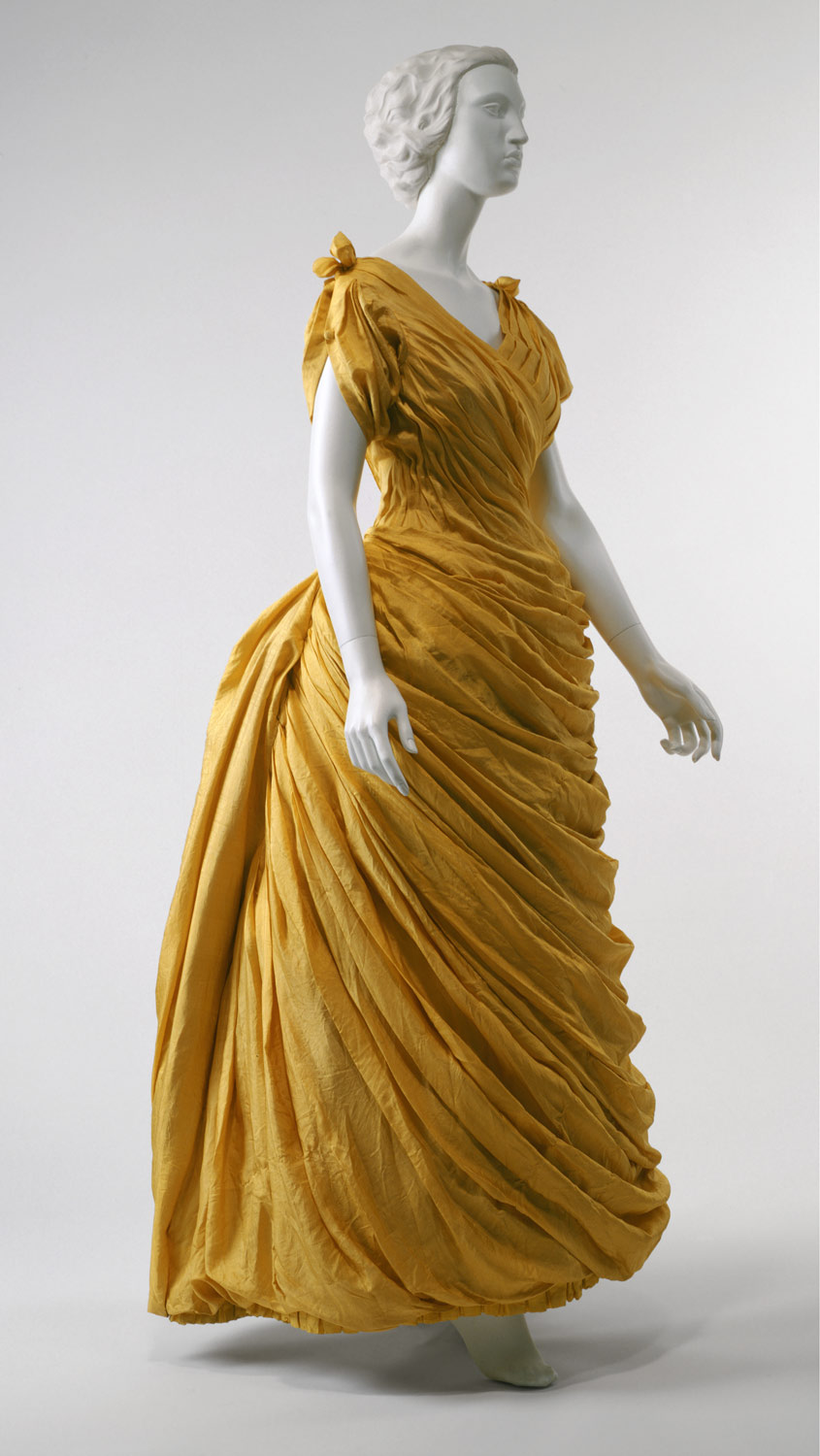 The design house Liberty & Company was known for its "artistic" dresses, with romantic and artisanal medieval effects, or faintly exotic and orientalizing motifs and silhouettes. This evening dress is particularly rare and unusual in that it fully incorporates what were viewed as classical elements of the period. The asymmetrical bodice with chiton sleeves alludes to the wearing of a himation anchored at one shoulder. Likewise, the two bowknots replace the fibulae that would have held together an ancient peplos. But the strongest classicizing detail of the gown is in its densely gathered silk, a technique that conjures the wet-drapery of classical statuary. While the gown's internal structure, with a wasp-waisted corset and bell-shaped underskirt, conforms to the fashionable hourglass silhouette of the period, its surface is intended to replicate the articulated folds that characterize classical renderings of drapery. This softly gathered surface would also have conveyed a tantalizing "naturalism." The consequence is an impression of the female body as less confined by the rectitude of a precise and controlled tailoring.
The design house Liberty & Company was known for its "artistic" dresses, with romantic and artisanal medieval effects, or faintly exotic and orientalizing motifs and silhouettes. This evening dress is particularly rare and unusual in that it fully incorporates what were viewed as classical elements of the period. The asymmetrical bodice with chiton sleeves alludes to the wearing of a himation anchored at one shoulder. Likewise, the two bowknots replace the fibulae that would have held together an ancient peplos. But the strongest classicizing detail of the gown is in its densely gathered silk, a technique that conjures the wet-drapery of classical statuary. While the gown's internal structure, with a wasp-waisted corset and bell-shaped underskirt, conforms to the fashionable hourglass silhouette of the period, its surface is intended to replicate the articulated folds that characterize classical renderings of drapery. This softly gathered surface would also have conveyed a tantalizing "naturalism." The consequence is an impression of the female body as less confined by the rectitude of a precise and controlled tailoring.http://www.metmuseum.org/toah/works-of-art/1985.155
Here are some pretty good articles as well,
http://hubpages.com/hub/FashionsofTheAestheticMovementACultofBeautyandVictorianCounterculture
http://cai.ucdavis.edu/waters-sites/aesthetic_movement/aesthetic_movement.html
The Eve of Saint Agnes
1863
Oil on canvas
117.8 x 154.3 cm
Purchased by HM Queen Elizabeth The Queen Mother
The Eve of St Agnes had been the subject of poems by both John Keats (1819) and Alfred, Lord Tennyson (1837), and these works inspired a number of drawings and paintings by Millais. This painting is based on a stanza from Keats’s poem. Keats based his poem on the superstition that a girl could see her future husband in a dream if she performed certain rites on 20 January, the evening before the feast day of St Agnes. St Agnes was a young Roman girl, martyred in the fourth century for her faith. Keats’s protagonist, Madeline, is unaware that her lover, Porphyro, is hidden in the room. Later the poem tells how Porphyro wakes Madeline and they daringly elope on the following day. Millais was inspired by the descriptive and evocative language of Keats’s poem. In the painting, the artist expresses the tension between romantic and sensual love, suspending Madeline in a pool of blue-green moonlight at the foot of her bed in anticipation of her vision.
Millais worked at night in the King’s Room at Knole in Kent to create a moonlit interior for Madeline, from Keats’s The Eve of St Agnes (1819). His model for Madeline was his first wife Effie. Her detailed jewel-like dress contrasts with the rapid brush-work elsewhere in the picture. Millais spent three and a half days at Knole and completed the picture in his London studio.
More found info
Aesthetic Dress:
Aesthetic dress of the late 19th century is sometimes also referred to as artistic dress. However, the term "artistic" tends to imply this fashion trend was limited only to those in the creative circles. While the fashion movement did get its origins amongst the artists of the period, aesthetic dress did spill over into mainstream fashion. Dresses were typically made of cotton, linen, velvet, wool, or oriental silk. They were slightly gathered at the waistline, had large puffed sleeves, long draping skirts, and often had a watteau back (a drape of fabric attached at the back of the neckline which falls to the floor). Favorite colors were lemon, green, cream, light brown, salmon-pink, deep purple, and other soft colors derived from natural dyes. The aesthetic dress movement lasted well into the early 20th century.

No comments:
Post a Comment